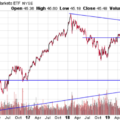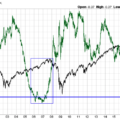In a Nutshell: The beginning of 2023 brought trend reversals across nearly all risk assets. We entered February with core markets at odds with each other and stock markets trading as if no recession is in sight for 2023, while the bond market appears priced for recession.
Domestic Equity: Recession Canceled?
We entered 2023 curious as to how stocks would respond in their attempt to break their down trend. We were especially curious since the forecasted economic data looks so weak in the first half of the year. We got the answer in January as stocks plowed through the down trend and are now trading above the 4100 resistance level, trying to flip the tide convincingly. Stocks were up about 8% in the first month of the year, making it one of the strongest Januarys in the last 50 years. Some unexpected positive, albeit noisy, economic data was reported to start the year and pushed stocks higher as many investors were caught offside, positioned for recession.
This reversal and breakout is quite convincing when you look under the surface and view participation as well. For the first time since 2021 we have more stocks making new highs than new lows. The key going forward is if we can maintain a positive number on this indicator on the next pull back for stocks. This is a very positive development for stocks, but it must be sustained.
Checking in on our sentiment indicator below, we see that we are stretched to the upside, so a pullback in stocks seems like the higher probability play from here. This is also occurring while stocks are at a key breakout level. Will this level hold if stocks pull back? Caution is certainly warranted here. While we are encouraged by the price action over the last few months, we are not ready to call for a new bull market. We could have neither: It’s also possible we’ll experience some sideways action for a while as stocks digest the positive short term data mixed with negative forward-looking data.
The Federal Reserve raised interest rates 0.25% to start February off, marking a reduction in the pace of interest rate increases, yet increasing nonetheless. The Fed remains resolute in raising rates to combat inflation, even at the risk of recession. The bond market finally agrees too. After months of the Fed stating their terminal rate for short term rates will be 5.1% and the bond market being unwilling to price that possibility in, bonds finally gave in. The bond market, for the first time since interest rates started going up, is now pricing in two more interest rate increases this year putting the short rates in the 5-5.25% range by May of this year. The bond market also remains convinced that interest rates will start to be cut by the end of 2023, which the Federal Reserve also refutes, stating they see rates staying higher for “a few years.” This dichotomy is possibly why the stock market and the bond market are seeing and pricing vastly different outcomes.
Global Equity: Convincing Break Out
Global equities have been in a bear market for nearly two years. Over the last two to three months a convincing end to that bear market is starting to take place. Digging down into the riskiest portion of global equity, emerging markets, we can see this dramatic reversal. Buoyed by China finally ending their Covid-related lockdowns and a government that is stimulating (as opposed to restricting) their economy, there are economic tailwinds in this sector for the first time in years. There is still work to be done from a price perspective, as levels that used to be resistance need to provide support for this rally to continue. We’ll continue to engage with this sector incrementally.
Real Estate: Breaking Out, Too?
Real estate followed stocks higher to start the year. In the process, the price action of real estate has put together a rather compelling reversal and breakout pattern, much like stocks. It was just two months ago that real estate was firmly entrenched in a downtrend and was relatively weaker than stocks. We’ll start to dabble in this space as long as this reversal holds. With weaker economic data still coming down the pike, we’ll move incrementally as we add exposure to this sector.
Commodities: Finally, the Break Lower
The commodities sector appears to have finally broken the downside support that had propped it up for the last six months. With inflation continuing to fall globally, we would expected to see commodities eventually trade lower. Any kind of sustained trading below the blue horizontal line below will likely give way to a new downtrend.
Gold got off to a great start for the year, up nearly 7% in January. Despite the good start there are some headwinds for the yellow metal. The first headwind is, oddly enough, seasonality. Gold’s best two months of the year for the past decade – by far – have been December and January. We are now out of the seasonal strength window. The second headwind is interest rates, as gold tends to trade inversely with interest rates. With the most recent pop in rates, gold has sold off a bit. We’d like to see gold find some footing above the top blue horizontal line in the chart below as an indication there is more upside from here.
Fixed Income: Interest Rates Down, But Not Out
Longer-term interest rates peaked in mid-October of last year, and that is precisely when stocks bottomed for the year as well. This was a continuation of the year-long relationship between stocks and bonds where stocks went up and rates down, and vice versa. This relationship continues to stay flipped from what we’ve observed over the last 50 years. As you can see below, the ten-year U.S. treasury yield has yet to let 3.5% break, but the trend is clearly down since the end of 2022.
As we mentioned to close out 2022, interest rates will be the key to all markets in 2023. If that 3.5% level breaks and heads lower, it’s very possible this is where the stock market starts to trade correlated to rates, and head lower as well. A break lower from here indicates economic growth concerns from the bond market and possibly recession in 2023. In fact, looking at forward rates, and the trusty yield curve chart below – which is now the most inverted we’ve seen in 40 years – evidence suggests the bond market is leaning towards a recession in 2023.
We reiterate that interest rates will be the key in 2023, and something we’ll continue to monitor to assess all risk assets this year.
All Terrain Portfolio Update
We continue to hold small positions in defensive stocks and precious metals as well as new positions in global equity. The vast majority of the model remains in risk averse, short-term treasuries and notes that are paying interest in the 4% to 5.5% range. Our data and outlook continue to be weak for the first half of 2023, so we will remain risk averse and agile until the data improves. We will continue to wait for investment opportunities and, in the meantime, follow our indicators and process to adjust risk as new data is presented.
Past performance is not indicative of future results. Other asset classes or investment vehicles may be used in client portfolios and client portfolios may not hold all positions of the model at the same time as the model. This chart and its representations are only for use in correlation to the proprietary timing model by Arkenstone Financial, Registered Investment Advisor. Actual client and All Terrain Portfolio(TM) positions may differ from this representation.
- U.S. Stocks Make New Highs - December 6, 2024
- Rising Rates Create Headwinds - November 8, 2024
- The Fed Finally Cuts Rates - October 10, 2024



Leave a Reply